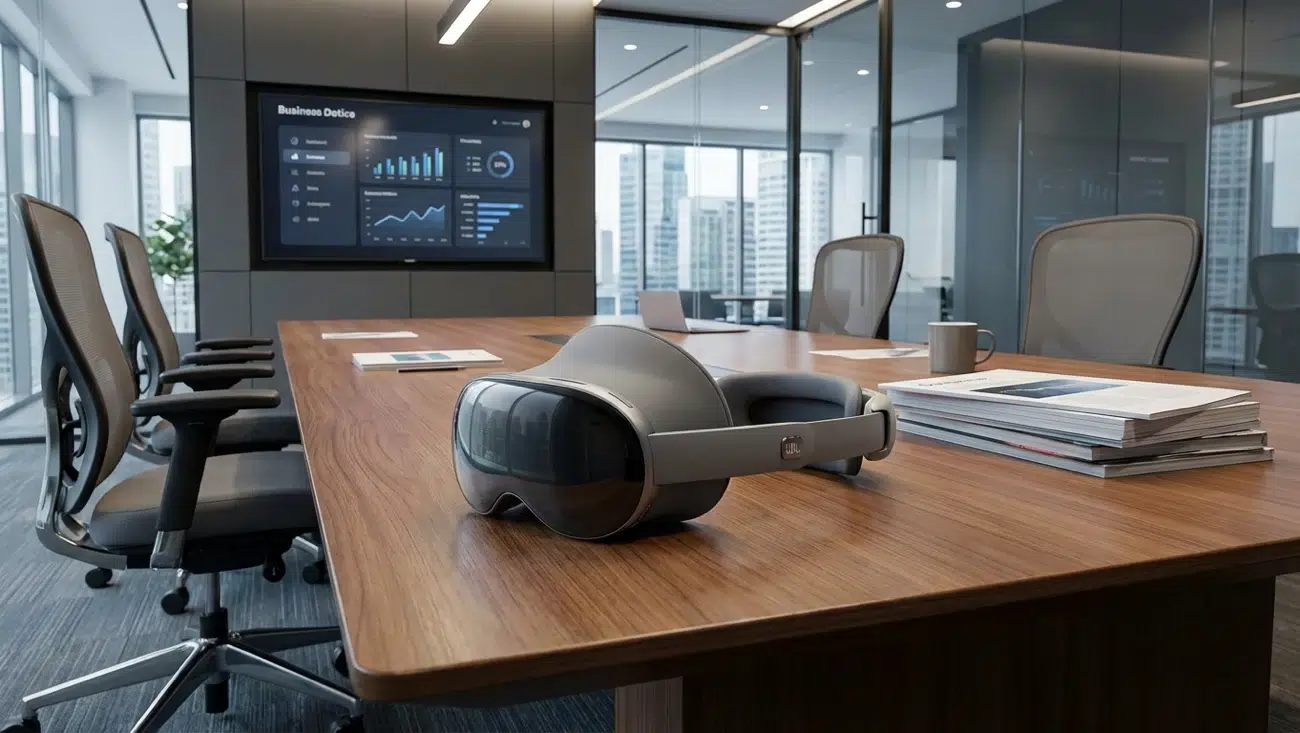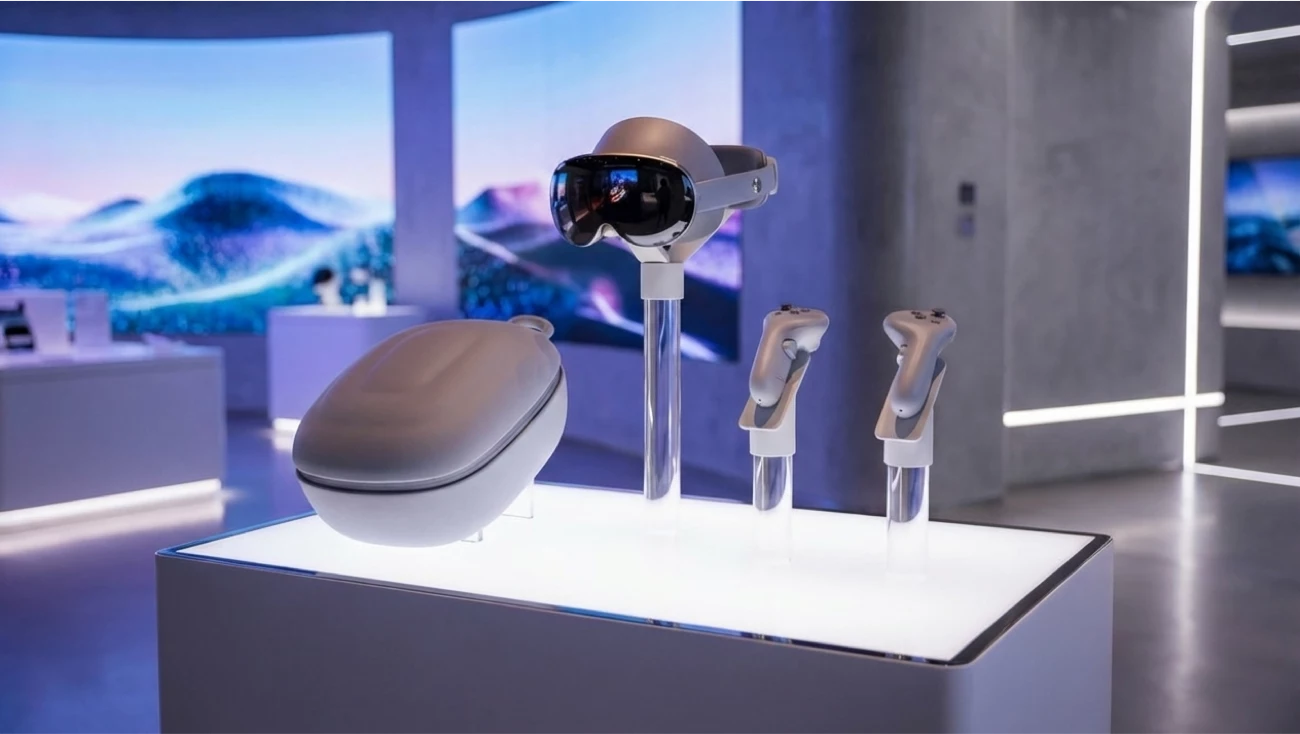A New Opportunity for Enterprise XR
The XR landscape has moved fast in 2025—and Samsung’s new Galaxy XR headset is one of the biggest shifts so far. Built on Android XR and designed with real work in mind, it sits perfectly between the Meta Quest lineup and the Apple Vision Pro in both price and capabilities. For companies exploring Enterprise XR App Development, the Galaxy XR opens the door to powerful immersive tools without the premium cost of Apple’s ecosystem.
At Frame Sixty, we’ve already started building and adapting our XR experiences for this device. Here’s how companies can take advantage of it.
Where the Galaxy XR Fits: Between Quest and Vision Pro
A balanced device for enterprise budgets
One of the biggest challenges in enterprise XR adoption is finding hardware that is both capable and scalable. The Samsung Galaxy XR directly targets that gap:
- More powerful than Meta Quest 3 (higher resolution, better passthrough, enterprise-friendly features)
- More affordable than Vision Pro (approximately half the price of Apple’s headset)
- Runs on Android XR, so integrations feel familiar to teams already using Android apps or workflows
Samsung designed this device in partnership with Google and Qualcomm, giving it a premium mixed-reality experience without the ultra-premium price.
For more details on Android XR itself, see our post:
👉 Android XR: The Next Wave of Spatial Computing

Capabilities Built for Real Work
Visual fidelity that supports professional tasks
Galaxy XR’s dual 4K micro-OLED displays deliver the clarity required for fields like design, simulation, medical visualization, or training. Text, 3D models, and interface elements appear crisp enough for long sessions—which is a requirement for enterprise workflows, not just entertainment.
Samsung’s official product page highlights these hardware capabilities:
👉 https://www.samsung.com/us/xr/galaxy-xr/galaxy-xr/
Natural interaction: hands, eyes, voice
The device supports:
- Full hand tracking
- Eye-tracking for gaze-based UI
- Voice input via Gemini AI
- Optional controllers for precision tasks
This multimodal input makes experiences more intuitive for non-technical teams and reduces onboarding friction.

Why Galaxy XR Is Strong Enough for Healthcare
Clinical-grade visualization
Many healthcare workflows require extreme accuracy. The Galaxy XR’s visual clarity and spatial sensors make it suitable for:
- Surgical training simulations
- 3D anatomy visualization
- Medical imaging overlays
- Guided procedures with spatial instructions
Modern healthcare XR products (e.g., MediView, GE Healthcare training tools) show how mixed reality can reduce errors and improve learning outcomes. The Galaxy XR meets the technical threshold to support this level of work.
Hands-free workflows
Doctors, nurses, and technicians often need both hands free. With Galaxy XR’s gesture + eye + voice system, teams can navigate clinical content without controllers—something that’s becoming essential in medical XR adoption. And when precision input is needed, the device also supports optional handheld controllers for more detailed interactions.

Mapping Galaxy XR Features to Key Industries
Manufacturing & Field Service
- Spatial instructions over real machines
- Maintenance overlays and IoT data visualization
- Remote assistance with shared mixed-reality view
These features help reduce training time and minimize operational downtime.
Architecture, Engineering, and Construction (AEC)
- Review full-scale building models
- Walk clients through immersive design previews
- Inspect structural layouts using passthrough mixed reality
The clarity of Galaxy XR’s displays makes CAD models far more usable than in previous mid-tier headsets.
Training & Education
- Interactive simulation-based learning
- Soft-skills practice in immersive settings
- Mixed-reality onboarding for new employees
XR training has already proven to increase retention and reduce costs—Galaxy XR makes it scalable.
Remote Collaboration
- Multi-window productivity tools
- Immersive meeting rooms
- Large virtual screens for analysis or presentations
Thanks to Android XR, apps like YouTube, Google Workspace, and Workspace-based productivity tools can run alongside custom immersive screens.
Enterprise XR App Development Strategy
A platform that reduces technical friction
Because Galaxy XR runs on Android XR, companies gain:
- Familiar development tools (Unity, Unreal, WebXR)
- Easier integrations with existing Android apps
- Faster deployment through enterprise MDM tools
- Fewer platform restrictions compared to visionOS
This dramatically simplifies early prototyping and reduces total cost of ownership.
Cross-platform XR is becoming a requirement
Enterprises increasingly expect XR experiences to work across:
- Meta Quest
- Apple Vision Pro
- Samsung Galaxy XR
- Future Android XR devices
This is where cross-platform XR development becomes essential.
Read more:
👉 Spatial Computing in Enterprise
Frame Sixty’s Work With Galaxy XR
Our multi-device approach

We’ve already begun adapting and building XR experiences specifically for the Galaxy XR. Because our XR pipeline already supports Vision Pro and Quest, bringing our apps into the Android XR ecosystem has been a natural evolution.
What this means for clients
Companies working with us can:
- Deploy XR across multiple devices
- Choose the hardware that fits the workflow
- Avoid vendor lock-in
- Scale XR more sustainably
Enterprise XR App Development is now truly multi-platform—and Galaxy XR strengthens that ecosystem.
How It Compares at a Glance
Galaxy XR vs Quest 3
- Higher resolution
- Better passthrough
- More enterprise-focused features
- Higher price, but much more capable for professional use
Galaxy XR vs Vision Pro
- Mid-range pricing
- Advanced mixed reality without Apple’s premium cost
- Slightly lower raw power, but still enterprise-grade
- Android XR ecosystem is more open and flexible
Conclusion
The Samsung Galaxy XR arrives at the perfect moment for enterprise adoption. It bridges the gap between consumer-focused headsets and ultra-premium hardware—offering the comfort, clarity, and power businesses need for training, healthcare, manufacturing, design, and collaboration.
For companies exploring Enterprise XR App Development, the Galaxy XR delivers the right blend of capability and accessibility. Combined with the flexibility of Android XR and an open ecosystem, it’s quickly becoming one of the most practical options for enterprise-ready XR solutions.
If your organization is planning to explore mixed reality, now is the ideal time.
FAQs
As interest in Samsung Galaxy XR and Android XR grows, developers and businesses often ask similar questions about capabilities, use cases, and development workflows. Below is an organized breakdown of the most common inquiries.
Q2: How does Galaxy XR compare to Vision Pro and Quest for business tasks?
Compared to Quest, Galaxy XR delivers higher resolution, better passthrough, and more enterprise-friendly features. Compared to Vision Pro, it offers similar mixed-reality capabilities at a significantly lower price, which can matter for large-scale deployments.
Q3: Is Samsung Galaxy XR suitable for non-technical teams?
Yes. Its interaction model—hand tracking, eye tracking, and voice input—reduces the learning curve for new users. Many companies adopt Galaxy XR specifically because it’s easy for teams without prior XR experience to onboard.
Q4: Which industries can benefit most from Galaxy XR?
Healthcare, manufacturing, architecture, engineering, education, logistics, and field operations can immediately leverage mixed reality for training, collaboration, and visualization.
Q2: Is it easy to bring an existing XR or mobile app to Galaxy XR?
If the app is already built for Quest or Android, porting can be straightforward. For immersive spatial interfaces, UI and interactions must be redesigned to take advantage of hand tracking and 3D layouts.
Q3: Does Galaxy XR support cross-platform XR development?
Yes. Apps built for Android XR can often be adapted to run on Quest or Vision Pro with shared codebases, especially when using Unity/OpenXR. This makes multi-device enterprise deployment more achievable.
Q4: Does Frame Sixty develop for Samsung Galaxy XR?
Yes. Frame Sixty has begun adapting and building immersive applications specifically for Galaxy XR as part of its multi-platform XR pipeline.
Q2: Can Galaxy XR be deployed at scale in corporate environments?
Yes. It supports Android Enterprise, MDM tools, remote app deployment, and integration with existing IT workflows. Companies can manage devices similarly to smartphones or tablets.
Q3: Is Galaxy XR powerful enough for demanding workflows like healthcare or engineering?
Absolutely. Its micro-OLED displays, accurate passthrough, eye/hand tracking, and Snapdragon chipset make it suitable for surgical simulation, 3D model review, spatial training, and real-time collaboration.
Q4: How should companies get started with Enterprise XR App Development?
Most organizations begin with a small proof-of-concept—training, design review, or field support—then scale to a multi-device strategy (Galaxy XR, Quest, Vision Pro). Working with an experienced XR studio like Frame Sixty helps ensure cross-platform compatibility from day one.

